Screen – Trash and foreign matter removal
村上定瞭(水浄化フォーラム), Sadaaki Murakami (Water & Solutions Forum)
スクリーンには、水浄化にのみでなく、農作物・加工食品・工業部品・廃棄物処理などにおいて、目的物をサイズによって固定物を分級する方法としても広く活用され、様々な方式が開発されている。ここでは、水浄化に多様されるスクリーンの主な方式について説明する。表1にスクリーンの代表的な方式を示す。
Screens are widely used not only for water purification but also as a method for classifying solid objects according to size in crops, processed foods, industrial parts, waste treatment, etc., and various methods have been developed. Here, the main methods of screens that are diversified for water purification will be described. Table 1 shows the typical screens.
Table 1 Typical screens for water purification.
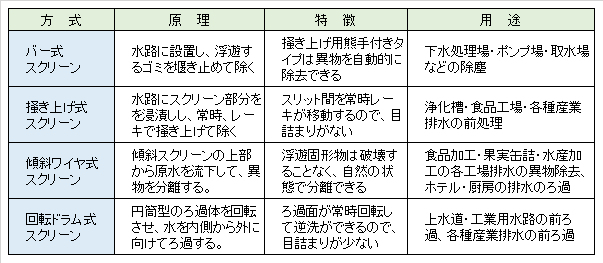
1.バー・スクリーン
バー・スクリーンは、円・角型の棒や板などを一定の平行間隔で外枠に固定したもので、ゴミや異物を取り除き、水を扱う分野で広く掻く活用されている。図1に溜池の放流口や農業用水路に設置されるバー・スクリーンを示す。主に、草や木の小枝・落葉などの粗大ゴミを取り除く。バーの間隔は5cm前後(荒目スクーン相当)である。スクリーンは垂直に設置され、適宜、熊手などで除去される。また、水道・工業用水路や一般水路などでは、天然粗大ゴミに加えて、廃棄された様々な粗大ゴミの除去に用いられている。傾斜バー・スクリーンも多用されている。
1. Bar screen
The bar screen is a circular/square type bar or plate fixed to the outer frame at regular parallel intervals to remove trash and foreign matter and remove water. It is widely used in the fields handled. Fig.1 shows the bar screens installed in the reservoir outlet port and the agricultural waterway. Mainly removes coarse trash such as grass, tree twigs and leafs. The distance between bars is around 5 cm (corresponding to a coarse scoop). The screen is installed vertically and removed with a rake or the like as appropriate. In addition to the natural waste, it is used to remove various discarded bulky wastes in waterways, industrial waterways and general waterways. The tilt bar screens are also heavily used.
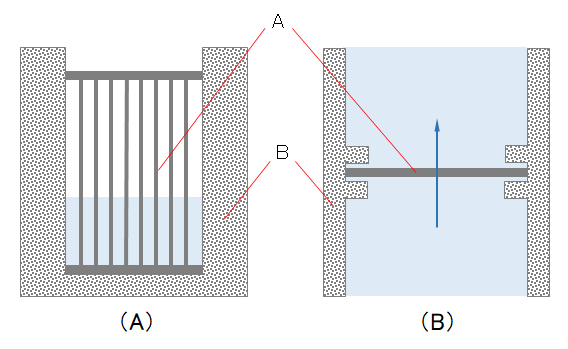
図1 バー・スクリーン:(A)正面図(B)平面図(上部)
A:ゴミ捕捉用のバー、B:水路のコンクリート壁
Fig.1 Bar screen: (A) Front view (B) Plan view (top).
A: Bar for collecting trash, B: Concrete wall of waterway.
2.自動掻き上げ式バー・スクリーン
上水道、下水道、大型浄化槽、食品工場などの水浄化工程の初段に設置される。上記バー・スクリーンに自動掻き上げ装置を付加したものである。水路に設置される事例を図2に示す。
スクリーンに捕捉されたゴミ・異物を掻き取る爪をチェーンやゴムベルトに取付て、常時掻き上げてゴミ・異物を排出する。掻き上げ装置は、スクリーンの表側または裏側に設置される。バーの隙間は1~50mmまであり、大きさによって18~300m3/hまで処理できる。
また、バーの代わりに、V型支持体に沿って、ゴムベルトそのものを上向きに回転させて、ゴミ・異物を取り除く方式も開発されている。
2. Automatic scraping bar screen
It will be installed at the first stage of water purification process such as water supply, sewer, large-scale septic tank, food factory. It is a bar screen with an automatic scraping device added. An example of installation in a waterway is shown in Fig.2.
Attach a claw to scrape trash and foreign matter captured on the screen to the chain or rubber belt, and always scrape up to discharge trash and foreign matter. The scraping device is installed on the front side or back side of the screen. There is a bar gap of 1 to 50 mm, and depending on the size, it can process up to 18 to 300 m3/h.
Instead of the bar, a method has also been developed in which the rubber belt itself is rotated upward along the V-shaped support to remove trash and foreign matter.
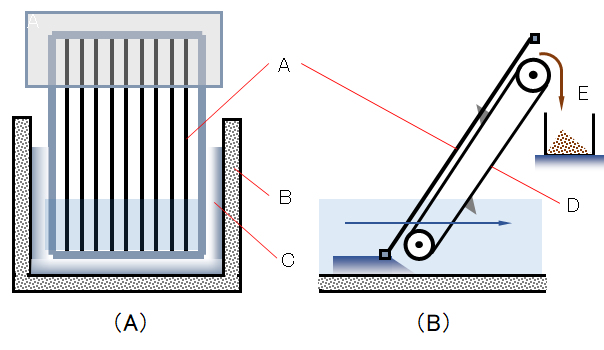
図2 バー式自動掻き上げ(裏掻き式)スクリーン:(A)正面図(B)側面図
A:バー・スクリーン、B:コンクリート水路壁、C:水路水の導入枠板、D:捕捉し渣の自動掻き上げ装置、E:し渣受け
Fig.2 Bar-type automatic scraping (back scraping) screen: (A) Front view (B) Side view.
A: Bar screen, B: Concrete waterway wall, C: Channel frame for introducing water, D: Automatic scraping device for trapping and removing residue, E: Residue receiver.
3.傾斜式ワイヤ・スクリーン
傾斜式ワイヤスクリーンは、原水をスクリーン上部から流下させ、ゴミ・異物を取り除く。目幅(ワイヤの平行間隔)は1~50mmまであり、40~800m3/hまで処理できる。(1) 噴射ノズルをスクリー面に沿って移動しスクリーンを自動的に洗浄する方式や (2) スクリーンを振動させてゴミ・異物を落下させる方式もある。
ワイヤスクリーンの代わりに、目的に応じた口径の穴を等間隔で開けた板状のスクリーンもある。
3. Inclined wire screen
The inclined wire screen allows raw water to flow down from the top of the screen to remove trash and foreign matter. The mesh width (parallel spacing between wires) is 1 to 50 mm, and can process up to 40 to 800 m3/h. There are also types such as (1) moving the jet nozzle along the screen surface to automatically clean the screen, or (2) vibrating the screen vibrating to drop trash and foreign matter.
Instead of the wire screen, there is also a plate-like screen in which holes having a diameter according to the purpose are formed at equal intervals.
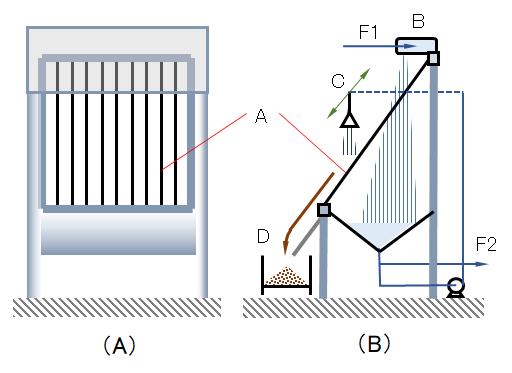
図3 自動洗浄型傾斜ワイヤー・スクリーン:(A)正面図(B)側面図
F1:流入原水、F2:処理水、A:ワイヤ・スクリーン、B:原水の散水装置、C:洗浄水噴射ノズル(上下移動式)、D:し渣受け
Fig.3 Self-cleaning inclined wire screen: (A) Front view (B) Side view.
F1: Inflow raw water, F2: Treated water, A: Wire screen, B: Watering device of raw water, C: Wash water injection nozzle (vertical movement type), D: Screen residue receiver.
4.回転ドラム式スクリーン
円筒構造の枠に微細な金網または繊維布(図4(A)の褐色円で示す部分)を貼り付けたドラムを低速回転させながら、このドラムに原水を流入させて、連続的に、ゴミ・異物・固形物を取り除く方式である。
1) ドラムの上部を水面上に残して本体を水路の水面下に浸漬し、原水をドラム入り口に導入し、原水をドラム面を通して内側から外側に流出させる方式。
2) 水路よりも低い位置に本体を設置して、原水をドラム内に導入し、原水をドラム面を通して内側から外側に流出させ、処理水受けで集水して排出方式。
いずれの方式も処理水をドラム上部ノズルより洗浄水を噴出して、スクリーンに付着したゴミ・異物を洗い落とす。
ドラム内にはらせん状の仕切り板を取り付けて、捕捉したゴミ・異物を回転により出口へ移送し排出する。本装置は狭い場所での使用が可能で、スクリーンの種類を目的に応じて変えることができるので、様々な分野で広く活用されている。
4. Rotating drum screen
A fine wire gauze or fiber cloth (shown by a brown circle in Fig.4(A)) is attached to the frame of the cylindrical structure drum is a system in which raw water is allowed to flow into this drum while rotating at low speed to continuously remove trash, foreign matter, and solid matter.
1) A method in which the main body is immersed under the water surface of the waterway, leaving the upper part of the drum above the water surface, introducing the raw water into the drum inlet, and letting the raw water flow from the inside to the outside through the drum surface.
2) Another method, install the main body at a position lower than the waterway, introduce the raw water into the drum, let the raw water flow from the inside to the outside through the drum surface, collect it in the treated water receiver, and discharge it.
In either method, the treated water is spouted from the drum upper nozzle to wash out the trash and foreign matter adhering to the screen.
A spiral partition plate is installed in the drum, and the captured trash and foreign matter is transferred to the outlet by rotation and discharged. Since this device can be used in a narrow place and the type of screen can be changed according to the purpose, it is widely used in various fields.
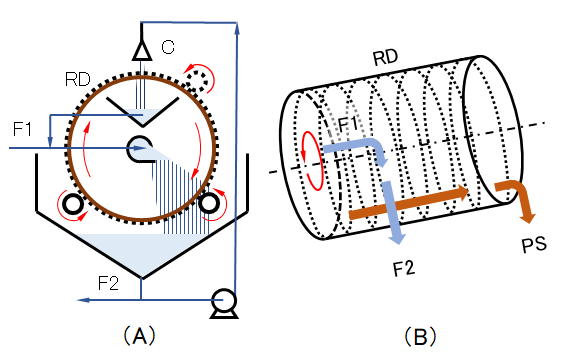
図4 回転スクリーン:(A)断面図(B)ドラムの立体モデル図
F1:流入原水、F2:処理水、RD:回転ドラムとスクリーン、C:捕捉し渣の洗浄ノズル、PS:し渣の排出
Fig.4 Rotating screen: (A) Sectional view (B) Three-dimensional model diagram of drum.
F1: Raw water, F2: Treated water, RD: Rotating drum and screen, C: Nozzle for cleaning residue trapped, PS: Discharge of residue.
5.生活排水のゴミ・異物除去
家庭では、台所の三角コーナー(ネット取付)、洗面台のヘヤキャッチャー、風呂場の排水口の目皿など、排水管の入口に調理くず・ゴミ・髪・異物を取り除く用具(スクリーン)が取り付けられている。洗濯機には、循環水・排水中の繊維くず・ゴミ・髪を捕捉するスクリーンが付設されている。これらのスクリーンが閉塞すると排水が不十分となるので、スクリーンを取り出して、ゴミ・異物を取り除き、付着したスライムをブラシ・タワシなどで洗浄・除去して、元の位置に装着している。
キッチン流しのゴミ受けの例を、写真 1a~1dに示す。ゴミ受けは2段になっていて、上段に粗ゴミネットと下段に微細ネット(水切りストッキング)を装着している。
5. Removal of trash and foreign matter from domestic wastewater
At home, drainage such as kitchen triangular corner (net attachment), washbasin hair catcher , bathroom drainage outlet eye plate , etc. A tool (screen) for removing cooking waste, trash, hair, and foreign substances is attached to the entrance of the drainage tube. The washing machine is equipped with a screen to catch fiber waste, trash and hair in circulating water and drainage. If these screens are clogged, drainage will be insufficient, so the screens are taken out to remove trash and foreign substances, and the slime that has adhered is washed and removed with a scrubbing brush, etc., and then attached to the original position.
Photos 1a to 1d show an example of the kitchen sink. There are two strainers with a coarse net on the top and a fine net (draining stockings) on the bottom.
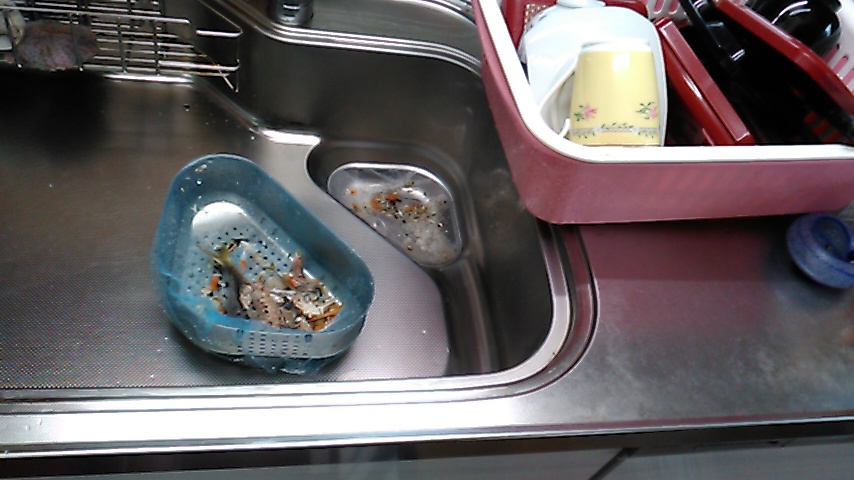
写真 1a フィルターネット交換前
Photo 1a Before replacing the filter net.
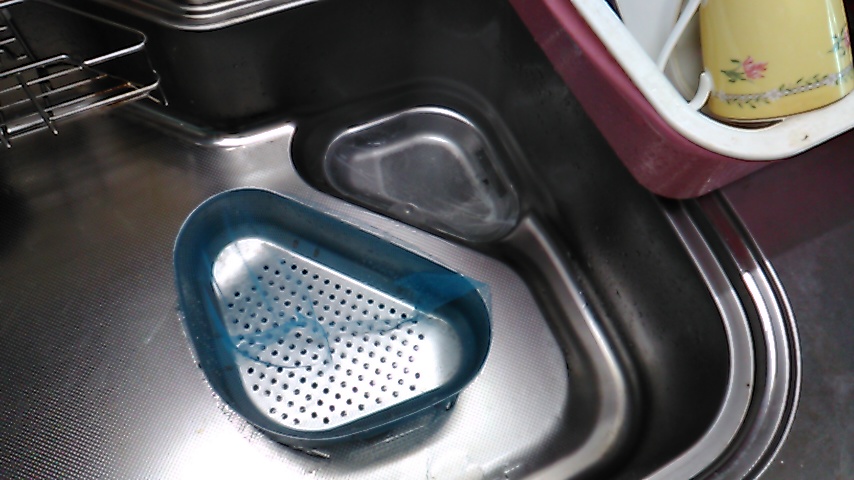
写真 1b フィルターネット交換後
Photo 1b After replacing the filter net.
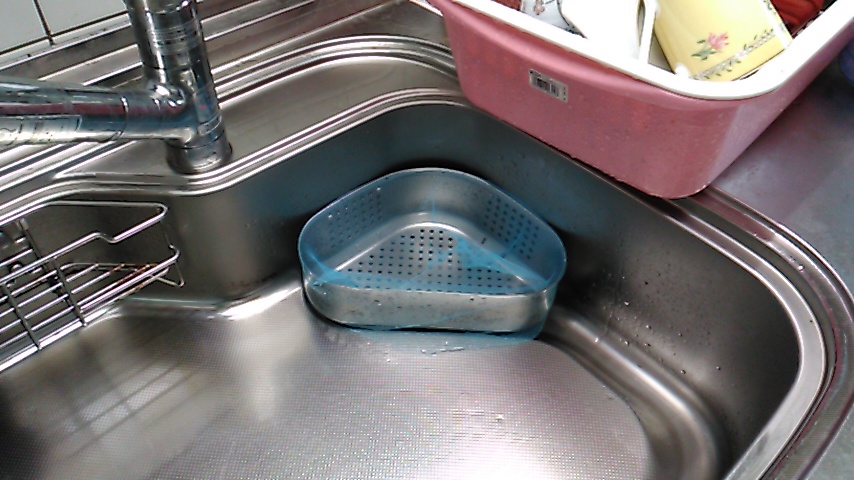
写真 1c 流しコーナーに設置
Photo 1c Installed in the sink corner.
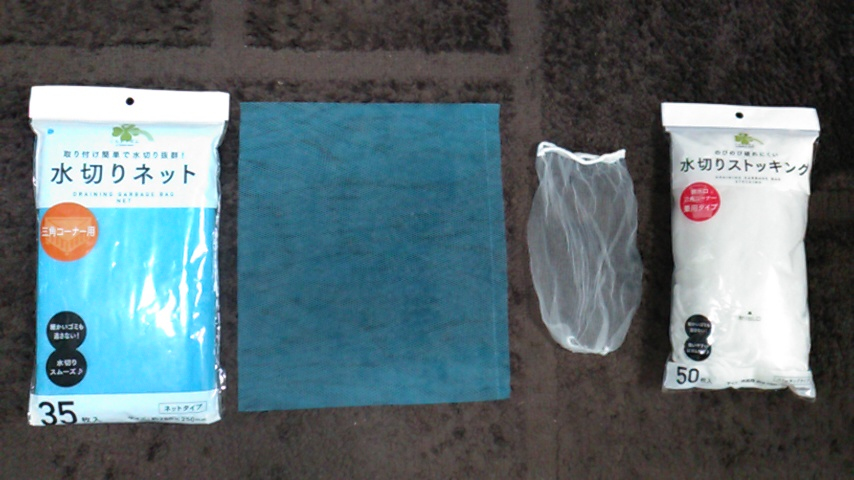
写真 1d フィルターネットの事例
Photo 1d Examples of filter nets.
下水汚泥中の異物除去の事例
余談であるが、編集者が下水処理施設から排出される混合汚泥を実験に供する場合には、前処理として、5cm、2cm、1cmの金網の円盤を一定間隔で水平に固定(エアリフト管と一体で、脱着可能)した円筒槽に汚泥を投入した後、汚泥をエアリフト循環して、ゴミ・異物を除去している。金網に捕捉されるゴミ・異物の大部分は、衣類の綿くずと髪である。砂は、円筒槽の底部に沈積するが、極めて少量である。居住部屋を掃除して、掃除機のフィルターに捕捉されるゴミの大部分も綿くずで、次に髪である。同じ傾向が、下水汚泥にも見られる。
Example of removing foreign matter from sewage sludge
As an aside, when the editor uses mixed sludge discharged from a sewage treatment plant for experiments, as a pretreatment, 5 cm, 2 cm, and 1 cm wire mesh disks are fixed horizontally at regular intervals (integrated with the air lift pipe). The sludge is put into a detachable cylinder tank, and the sludge is circulated by air lift to remove trash and foreign matter. Most of the trash and foreign substances captured by the wire netting are cotton trash and hair of clothes. Sand deposits on the bottom of the cylindrical tank, but in very small amounts. Most of the debris trapped in the vacuum cleaner’s filter when cleaning a living room is also cotton litter, and then hair. The same tendency is found in sewage sludge.
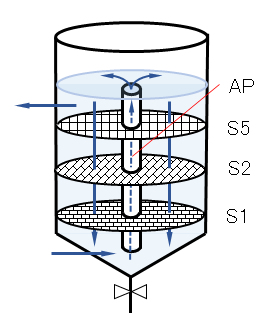
図5 実験供試用の下水混合汚泥からのゴミ・異物除去の事例
AP:汚泥循環用エアリフト管、S5:5cm金網、S2:3cm金網、S1:1cm金網
Fig.5 Example of removing trash and foreign matter from sewage mixed sludge for experimental test.
AP: Air lift pipe for sludge circulation, S5: 5cm wire mesh, S2: 3cm wire mesh, S1: 1cm wire mesh.
掲載:2017年12月09日
更新:2018年06月17日(写真・動画を追加)
更新:2020年07月23日(英語版を追加)
Posted: December 9, 2017
Update: June 17, 2018 (Photos and videos added)
Update: July 23, 2020 (English version added)
